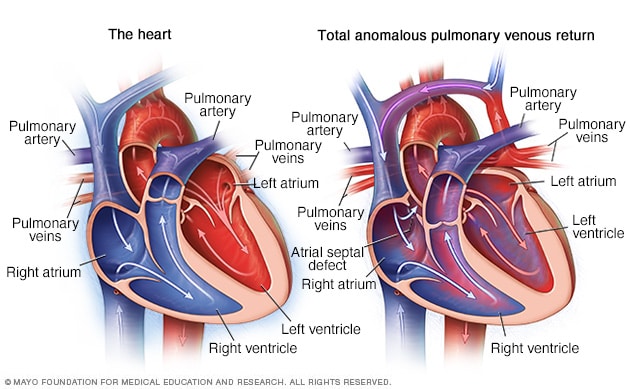Total anomalous pulmonary venous return (TAPVR)
Total anomalous pulmonary venous return

Total anomalous pulmonary venous return
In total anomalous pulmonary venous return (TAPVR), the pulmonary veins incorrectly send blood to the heart's upper right chamber. That chamber is called the right atrium. As a result, oxygen-rich blood mixes with oxygen-poor blood, as shown in purple. In a typical heart, shown on the left, oxygen-rich blood flows from the pulmonary veins to the upper left chamber, also called the left atrium.
Total anomalous pulmonary venous return (TAPVR) is a rare heart condition that's present at birth. That means it's a congenital heart defect.
Other names for this condition are:
- Total anomalous pulmonary venous connection.
- TAPVC.
In this heart condition, the lung blood vessels, called the pulmonary veins, attach to the wrong place in the heart.
In a typical heart, oxygen-rich blood flows from the lungs to the upper left heart chamber, called the left atrium. Blood then goes to the rest of the body.
In TAPVR, the connection of veins is changed. Blood flows through the upper right heart chamber, called the right atrium. This change in blood flow causes oxygen-poor blood to mix with oxygen-rich blood. As a result, blood flowing to the body doesn't have enough oxygen.
The type of TAPVR depends on where the veins connect. Most children born with TAPVR have no family history of congenital heart disease.
Symptoms
Symptoms of total anomalous pulmonary venous return (TAPVR) in babies may include trouble breathing, poor feeding and a weak pulse. The baby's skin may look gray or blue due to low oxygen levels. This is called cyanosis. Depending on skin color, these changes may be easier or harder to see.
Symptoms of TAPVR may appear soon after birth. But some people don't have symptoms until later in life.
When to see a doctor
Serious congenital heart defects are often diagnosed before or soon after a child is born. If you think that your baby has symptoms of total anomalous pulmonary venous return (TAPVR), call your child's healthcare professional.
Causes
Most congenital heart defects are caused by changes that happen early as the unborn baby's heart is developing before birth. An unborn baby is also called a fetus. The exact cause of most congenital heart defects, including total anomalous pulmonary venous return (TAPVR), is not known.
Changes in the genes, some medicines or health conditions, and environmental or lifestyle factors, such as smoking, may play a role.
Risk factors
Possible risk factors for congenital heart defects, including total anomalous pulmonary venous return (TAPVR), may include:
- Rubella, also called German measles. Having rubella during pregnancy can change how the baby's heart develops. A blood test can be done before pregnancy to see if you're immune to rubella. If you're not, you can get a vaccine.
- Diabetes. Having type 1 or type 2 diabetes during pregnancy may change how the baby's heart grows during pregnancy. Diabetes that develops during pregnancy is called gestational diabetes. Gestational diabetes generally doesn't increase the risk of congenital heart disease.
- Genetics. Although TAPVR doesn't usually run in families, changes in genes have been linked to heart conditions at birth. For example, people with Down syndrome are often born with heart conditions.
- Smoking. If you smoke, quit. Smoking during pregnancy or exposure to secondhand smoke increases the risk of congenital heart defects in the baby.
- Alcohol use. Drinking alcohol during pregnancy has been linked to heart conditions in the baby.
- Some medicines. Some medicines taken during pregnancy may increase the risk of congenital heart defects. These include lithium (Lithobid) for bipolar disorder and isotretinoin (Claravis, Myorisan, others), which is used to treat acne. Talk to your healthcare team about the medicines you take.
Diagnosis
To diagnose total anomalous pulmonary venus return (TAPVR), a healthcare professional listens to the heart and lungs. A whooshing sound, called a heart murmur, may be heard.
An echocardiogram is the test used to diagnose total anomalous pulmonary venous return. It uses sound waves to create images of the heart as it beats. An echocardiogram can show the pulmonary veins, any holes in the heart and the size of the heart chambers. It also shows blood flow through the heart and heart valves.
Other tests such as an electrocardiogram, a chest X-ray or a CT scan may be done if more information is needed.
Treatment
Total anomalous pulmonary venous return (TAPVR) is treated with surgery. The surgery usually is done when a child is a baby. The timing of surgery depends on whether there's a blockage. To repair the heart, surgeons connect the pulmonary veins to the left upper heart chamber. They also close the hole between the upper heart chambers.
A person with TAPVR needs regular health checkups for life to check for infection, blockages or irregular heartbeats. A doctor trained in congenital heart diseases should provide care. This type of healthcare professional is called a congenital cardiologist.
Dec. 07, 2024